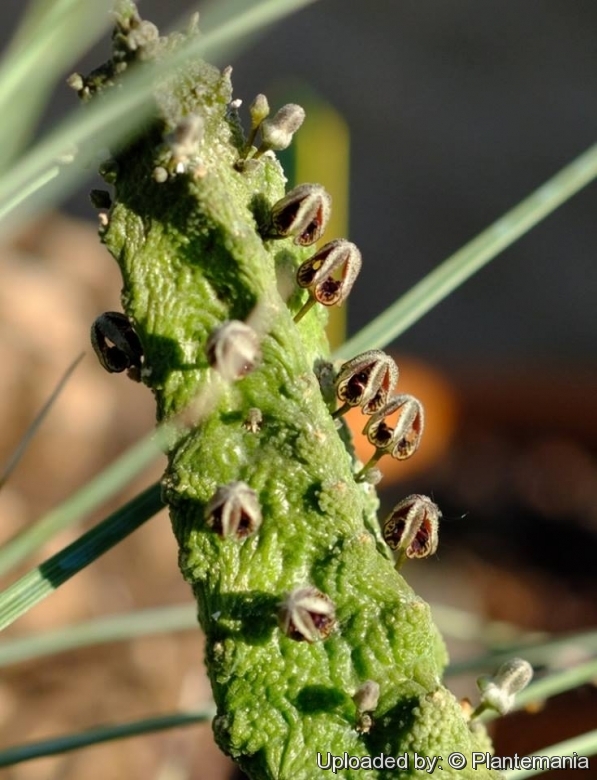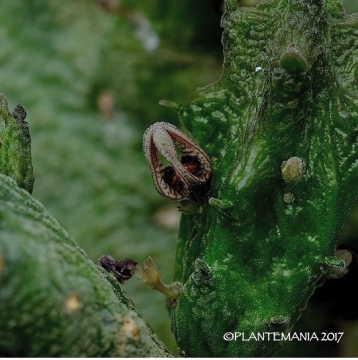




Your support is critical to our success.

Origin and Habitat: Rhytidocaulon fulleriSN|34257]]SN|34257]] is found in the Dhofar coast, Muscat and Oman, southern Arabia.
Habitat and ecology: This species grows along the bed of rivers that dry up in the dry season.
Synonyms:
- Rhytidocaulon fulleri Lavranos & Mortimer
Description: Rhytidocaulon fulleriSN|34257]]SN|34257]] is a low growing, nearly leafless succulent with thick almost horizontally growing grey- to brown-green stems. The plants are extremely cryptic or even unnoticeable because they perfectly blends with their surroundings. It has small cage like flowers that are not the most spectacular, but it remains an interesting plant.
Stems: Main stem, branched sparingly from base, prostrate or ascending up to (10-)20(-35) cm long and about (1.5-)2(-2.5) cm thick, indistinctly square or .five angled in section, rather, surface very rough, wrinkled, strongly furrowed and tessellated with a thick waxy coating, fresh growth at tip blue-green, older parts of stem grey-green to brown-green. Branches shorter and more slender. Tubercles raised and rounded.
Leaves: Rudimentary, ephemeral (soon shedding), near apex of stem fleshy, triangular-ovate, 1.5-3 mm long.
Inflorescence: Nearly stemless, 1- to 3-flowered, solitary or in pairs over the young parts of the stem and long-lived.
Flowers: Very small, cage like from the fused lobe tips, rich in nectar and unscented. Pedicels 0.5-2 mm long, papillated. Calyx 5-lobed, lobes (sepals) deltoid, 1-3 mm long, papillated. Corolla 5-lobed, (4-)8-10 mm long (2.5)4-4.5(-5) mm across, inside with brownish red transverse lines on a greenish to cream-coloured background, glabrous, outside flecked with red-brown, papillated. Corolla tube shallow, short. Corolla lobes erect, free almost to base, linear-spathulate, narrowest near the middle, connivent at their tips, margins recurved, 4-9 mm long 1.5-2 mm wide, folded back along the midrib, tips inside often red. Corona up to 1 mm tall and about 2-3.5 mm across. Outer corana, fused bowl-like, lobes broadly bifid nearly triangular with erect basal processes, deep red-brown, fused above with the laterally neighbouring appendages to form a triangular beak. Inner lobes pink or yellow, 1-1.5 mm long, rectangular-oblong, inwardly directed. Pollinia ovoid to pear-shaped.
Fruits: Paired, erect, linear-ellipsoid with attenuate tip, up to 3-4 cm long and 4 mm thick, pale blue-green to green-brown, with reddish hoops.
Seeds: About 6 mm long and 3 mm wide.
Bibliography: Major references and further lectures
1) Anthony G. Miller, Miranda Morris, Susanna Stuart-Smith “Plants of Dhofar: The Southern Region of Oman : Traditional, Economic and Medicinal Use” Office of the Advisor for Conservation of the Environment, Diwan of Royal Court, 1988
2) Lavranos, J.J. Mortimer, K.V. “Rhytidocaulon fulleri, a new stapeliad from the Dhofar Coast, Muscat and Oman, Southern Arabia” Natl. Cact. Succ. J. 25: 3 1970.
3) Focke Albers, Ulrich Meve “Illustrated Handbook of Succulent Plants: Asclepiadaceae” Springer Science & Business Media, 06 December 2012

Rhytidocaulon fulleri Photo by: © Plantemania
The gallery now contains thousands of pictures, however it is possible to do even more. We are, of course, seeking photos of species not yet shown in the gallery but not only that, we are also looking for better pictures than those already present. Read More...
Cultivation and Propagation: It is a summer-growing species that like many of the plants of this family which comes from Arabia and Yemen is not easy to cultivate. This plant is extremely xerophytic, adapted to very dry soils and is quite susceptible to over-watering if kept in a non ventilated place.
Growth rate: Relatively fast-growing that offsets freely to form small clusters quickly.
Soil: Grow it in an open mineral, sandy-gritty cactus compost and provide a very good drainage.
Exposure: Keep in part to full shade. It has a good heat tolerance.
Watering: Water during the growing period and let dry out when it is dormant. Mature individuals easily rot and die especially after transplanting so be extremely cautious with watering. Keep dry in winter or when night temperatures remain below 10° C. Water it less than average if in bigger pots.
Fertilization: Feed them once during the growing season with a fertilizer specifically formulated for cactus and succulents (high potash fertilizer with a dilute low nitrogen), including all micro nutrients and trace elements diluted to ½ the strength recommended on the label. They thrive in poor soils and need a limited supplies of fertilizer to avoid the plants developing excess vegetation, which is easily attacked by fungal diseases.
Special need: It is suited for airy exposures. Provide very good ventilation. Nearly all problems occur as a result of overwatering and poor ventilation, especially when weather conditions are dull and cool or very humid. They must have very dry atmosphere.
Hardiness: It will not tolerate low temperatures (recommended minimum winter temperature 5° to 10° C)
Pests & diseases: These succulents may be attractive to a variety of insects, but plants in good condition should be nearly pest-free, particularly if they are grown in a mineral potting-mix, with good exposure and ventilation. Nonetheless, there are several pests to watch for:
- Mealy bugs: Mealy bugs occasionally develop aerial into the new leaves and flowers with disfiguring results, but the worst types develop underground on the roots and are invisible except by their effects.
- Rot: This species will not tolerate high humidity, frequently succumbing to fungal attacks if kept in sub-optimal conditions. If they are not watered and “aired” correctly, fungicides won't help all that much.
Propagation: Seeds, cuttings or grafting.
| Your Actions | |
|---|---|
| Back to Rhytidocaulon index | |
| Back to Asclepiadaceae index | |
 |
Back to Succulents Encyclopedia index |
Privacy stantement - Terms and conditions - How to cite - About us - Feedback - Donate



